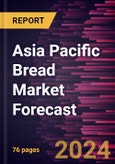Increasing Demand for Convenience and Ready-To-Eat Products Fuel the Asia Pacific Bread Market
The Asia Pacific bread market is experiencing a surge in demand due to the increasing preference for convenience and ready to eat products. The hectic lifestyle of modern consumers, coupled with the need for quick and easy meal solutions, have led to a significant rise in the consumption of bread. Convenience driven factors such as ease of preparation, longer shelf life, and portability make bread a popular choice among busy individuals. Additionally, the availability of a wide variety of bread options, including loaves, sandwich bread, baguettes, burger buns, etc. caters to diverse consumer preferences and dietary requirements.Furthermore, the COVID-19 pandemic has also contributed to the surge in the bread market. During lockdowns and restrictions, consumers turned to staple foods like bread, which are easy to store and have a longer shelf life. The pandemic induced rise in home baking and cooking activities also boosted the demand for bread, as people sought comfort in homemade meals and snacks. As a result, bakeries and bread manufacturers experienced increased sales and expanded their product offerings to cater to changing consumer preferences.
In conclusion, the increasing demand for convenience and ready to eat products, coupled with the impact of the COVID-19 pandemic, has significantly contributed to the growth of the global bread market. With consumers seeking quick and easy meal solutions, the demand for a variety of bread products continues to rise. As the market evolves, manufacturers are likely to innovate further to meet the changing needs and preferences of consumers, driving the expansion of the Asia Pacific bread market.
Asia Pacific Bread Market Overview
The bakery industry in Asia Pacific has shown significant growth owing to the rising consumption of bakery products in India, Japan, China, and other countries in the region. According to the US International Agricultural Trade Report, in 2021, per capita consumption of baked products in China and Japan was 7.2 kg/year and 22.5 kg/ year, respectively. Also, retail sales of baked goods in China are expected to reach US$ 53 billion by 2025, a 53% increase compared to 2021. The demand for different types of bread is increasing in Asia Pacific due to a rising consumer preference for convenient and ready-to-eat food products especially baked goods (bread, baguettes, and buns and rolls), along with the shift toward Western-style diets. Furthermore, as urbanization continues to accelerate and lifestyles become increasingly hectic, the consumers in the region are seeking quick and convenient meal options, making bread an attractive choice due to its ease of consumption. The growing awareness regarding health and wellness has prompted consumers to look for healthier bread options, such as whole-grain, multigrain, and gluten-free varieties, which offers nutritional benefits. Therefore, consumers in the region are increasingly opting for millet-based food products in their meals. To cater to the millet-based bakery products demand of the consumers, Asia Pacific bakery brands are increasingly launching new products. For instance, in April 2023, Britannia, a brand of Bonn Group, launched “Millet Bread” with zero added Maida for Indian consumers. This bread product is incorporated with ragi, jowar, bajra, and oats and has fiber and minerals that provide consumers with a convenient way to include millet-based options in their meals. Thus, nutritional product innovations by the key players are driving the bread market across the region. However, in India, China, South Korea, and other Asian countries, traditional food habits and cultural preferences still prioritize rice, wheat, millet, pulses, dairy, vegetables, fruits, noodles, and other staple foods over bread, thereby limiting its market penetration in Asia Pacific.Asia Pacific Bread Market Revenue and Forecast to 2030 (US$ Billion)
Asia Pacific Bread Market Segmentation
The Asia Pacific bread market is segmented based on type, category, distribution channel, and country.By type, the Asia Pacific bread market is segmented into loaves, sandwich bread, baguettes, burger buns, and others. The loaves segment held the largest market share in 2022.
Based on category, the Asia Pacific bread market is bifurcated into organic and conventional. The conventional segment held a larger market share in 2022.
By distribution channel, the Asia Pacific bread market is segmented into supermarkets and hypermarkets, specialty stores, online retail, and others. The supermarkets and hypermarkets segment held the largest market share in 2022.
In terms of country, the Asia Pacific bread market is segmented into China, India, South Korea, Australia, Japan, and the Rest of Asia Pacific. The Rest of Asia Pacific dominated the Asia Pacific bread market share in 2022.
Campbell Soup Co., Groupo Bimbo SAB de CV, Dr Schar AG, Bakers Delight Holdings, and Britannia Industries Limited are some of the leading players operating in the Asia Pacific bread market.
Reasons to Buy
- Save and reduce time carrying out entry-level research by identifying the growth, size, leading players, and segments in the Asia Pacific Bread Market.
- Highlights key business priorities in order to assist companies to realign their business strategies
- The key findings and recommendations highlight crucial progressive industry trends in the Asia Pacific Bread Market, thereby allowing players across the value chain to develop effective long-term strategies
- Develop/modify business expansion plans by using substantial growth offering developed and emerging markets
- Scrutinize in-depth Asia Pacific market trends and outlook coupled with the factors driving the Asia Pacific Bread Market, as well as those hindering it
- Enhance the decision-making process by understanding the strategies that underpin commercial interest with respect to client products, segmentation, pricing, and distribution
Table of Contents
Companies Mentioned
- Campbell
- Grupo Bimbo, S.A.B. de C.V.
- Dr Schar AG
- Bakers Delight Holdings
- Britannia Industries Limited








